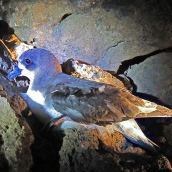Fea’s Petrel, Gon-gon (Pterodroma feae)
A pelagic seabird, up to 35 cm long, wingspan 86-94 cm. Greyish-black upperparts, crossed by a dark W-shaped band, and white underparts; the underside of the wings is dark grey. The bill, which is rather stubby, has tubular external nostrils (a characteristic of Procellariiformes) through which excess sea salt is eliminated. This seabird is endemic to Cape Verde and nests on the islands of Santo Antão, São Nicolau, Santiago and Fogo, but there are no recent data for Santiago. Surprisingly, it breeds inland on vertical cliffs and rugged peaks, just like Freira or Zino’s petrel (Pterodroma madeira). Breeding occurs from January to April and a single egg is laid in hollows or crevices, located under large rocks and inaccessible ledges. Information on population development is scant but there is evidence of considerable decline in recent decades. A study carried out in January-February 1998 estimated the existence of around 200 pairs in Santo Antão, 30 in São Nicolau and 80 in Fogo. Fea’s petrels are often sighted in waters that surround the islands of Cape Verde. Other threats include predation by introduced cats and capture by the local population for medicinal purposes, but fortunately many breeding colonies are situated in extremely remote spots. The species has been classified as near threatened on the IUCN Red List. However, the current trend of separating (morphometrically and genetically) the Cape Verde and Desertas Islands (P. deserta) seabirds points to a need to reconsider this conservation category, since it also includes populations from Madeira.













